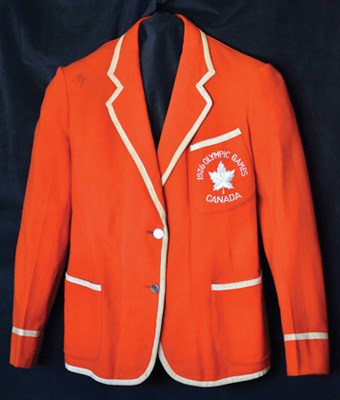FOR years, the bright orange blazer hung in Toni Dembicki's closet.
Every so often, she would bring it out to show friends the wool jacket with crisp white piping and mother-of-pearl buttons. The label shows it had been "styled and tailored" by Deacon Sport Wear in Belleville, Ont., and once belonged to one Catherine Gordon Lang.
A badge embroidered on the front pocket reads "1936 Olympic Games, Canada."
The jacket is a memento of the journey Dembicki's mother took in 1936 to join the rest of Canada's Olympic team in Berlin. Catherine "Bunny" Lang travelled to Germany aboard the Queen Elizabeth I.
The jacket is now in the collection of Dance Collection Danse, an archive of Canadian theatrical dance.
While Dembicki felt strongly that the jacket should be taken out of the closet and put on display for everyone to see, she was unprepared for how it would feel to part with the beloved piece of clothing.
"I didn't realize how emotional it was going to be when I actually sent it in the mail," says Dembicki. "I actually cried because it was like I was sending away the last piece of my mom."
Lang wasn't an athlete, but a dancer who participated in an international cultural showcase alongside the Olympics. It was the first time outside of Canada for the diminutive 23-year-old ballerina from Toronto. Unlike today's Olympics, the dancers marched with the athletes in the opening ceremonies.
"That's what's sort of different about the more current Olympics, is that they were really considered a part of the Canadian team," says Amy Bowring, director of collections and research at Dance Collection Danse.
The 1936 Olympics, the last Games held before the Second World War, marked the first time the outside world got a good look at the Nazi regime. Adolf Hitler had intended the 1936 Games to demonstrate his ideals of Aryan superiority. Berlin was the first time an Olympic Games was televised, and an unsettling mix of rigid discipline and military might was on display.
"I do remember (my mother) telling me that they were standing at the train station and I guess Hitler was supposed to be somewhere in the crowd somewhere," says Dembicki. "Everybody was supposed to go 'Heil Hitler' - the team didn't do that and the guards took their rifles and shoved it into their sides to make their arms go up."
While the non-competitive dance festival had a congenial feel, with dancers from Canada, several European countries and India competing, there was one notable absence.
"The Americans were not there," says Bowring. "Martha Graham had been invited and she declined, because she had so many Jewish dancers in her company . . . she didn't like the politics of it."
The Canadian dancers who headed to the Olympics were part of a semi-professional company headed by Boris Volkoff, a member of the Russian Imperial Ballet who came to Canada in 1929 and is acknowledged as the father of Canadian ballet.
Many of the dancers he trained later became the first members of the National Ballet of Canada, which was founded in 1951.
A different fate was in store for Bunny Lang: Romance and then marriage to a handsome young architect who was an Olympian in his own right. Ned Pratt had won a bronze medal in rowing during the 1932 Olympics in Los Angeles.
The Pratts married in 1937 and lit out for the West Coast in late 1938, living in a cottage on the beach in the Dundarave neighbourhood of West Vancouver during most of the 1940s.
Ned Pratt had joined the air force and was stationed in Bella Coola for most of the war, where, says Dembicki, he was "totally bored because he was supposed to be looking for airplanes and he never saw any."
He spent the time writing letters to his new wife, exhorting her to "get out early and collect the wood before all those other West Vancouver babes," recalls Dembicki.
The couple - now a family of four with the birth of Peter in 1940 and Toni in 1944 - left the lean war years and their humble beach cottage behind in the late 1940s.
Ned Pratt, who was a contemporary of B.C. Binning and a practitioner of the West Coast Modernist style, built a post-and-beam home in the British Properties in 1951. Ned and Bunny Pratt lived there for the rest of their lives. The home was recently restored by Dembicki's brother, Peter Pratt, who is also an architect.
While raising two children and becoming active in organizations like the local Junior League, Bunny Pratt also taught dance for many years.
"She loved dancing, she absolutely loved it," says Dembicki, describing her mother as a quick-witted, confident woman who shone in social situations.
"People loved to talk to her, and she loved to talk to people," says Dembicki.
She also supported her creative husband, acting as a soundboard for his ideas - and playing the odd prank on the absent-minded architect.
"My dad, when he got undressed . . . he would just drop his clothes, so my mom got a hammer and nails and nailed his clothes to the floor," recalls Dembicki, laughing at the memory. "When he went to get his socks, they were nailed (down)."
Dembicki notes how her mother kept her Olympic jacket in perfect condition, whereas her father's jacket "was just a mess."
Ned Pratt's jacket and bronze medal are now included in the collection of the B.C. Sports Hall of Fame.



